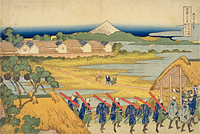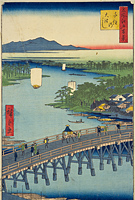Senju
Back : Find on a modern map Back : Find on a detailed map of Edo Back : Arakawa-ku Back : Adachi-ku Back : Imado Minowa Asakusa ezu
- Current Address
- Adachi-ku, Senju / Arakawa-ku, Minamisenju
- Description
- There are several theories for the origin of the area name, some say it is related to the senju (thousand hand) Kannon statue that was located at Shosen-ji Temple, and others say it was related to the fact that the Chiba clan lived there (In Japanese the first character of the name "Chiba" can be read as "sen" and "ju" can mean lived, so this could mean something like "place where the Chiba clan lived"). This was the first post station on the Nikko-kaido Road (Oshu-kaido Road) and one of the 4 posting stations of Edo. In 1594 the Senju-ohashi Bridge was constructed on the Arakawa-river (present day Sumida-gawa River), and the area developed as an important place for transportation and travel in conjunction with the construction of the mausoleum of Tokugawa Ieyasu and Tokugawa Iemitsu in Nikko in 1625. From the Kyoho Era (1716-36) onward, morning markets were held every day in the "yacchaba" within the posting stations, and were as popular as the fish markets of Nihonbashi. The area also supposed Edo's prosperity through water transport as a stopping point on the Kawagoe yofune (Kawagoe evening ships) which linked Kawagoe and Edo in a single evening and transported tourists as well as grain, fuel and fresh fish. There was an execution ground in Kozukahara on the southern coast, which was known as the area where Sugita Genpaku and Maeno Ryotaku attended the autopsies of executed criminals in 1771. In 1667, the Ekoin Temple was established in order to hold memorial services for those who died while in prison or who were executed.







